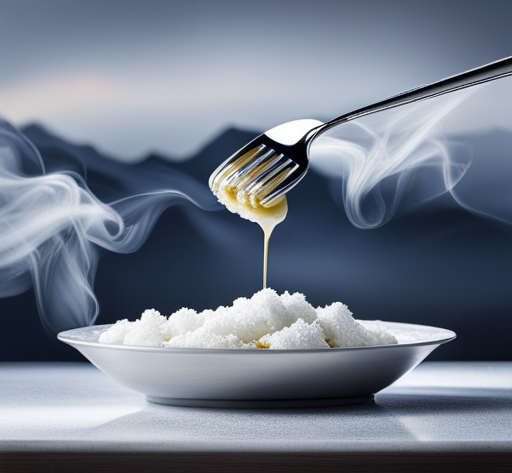Did you know that over 90% of households in the United States have a frozen dinner tucked away in their freezer?
But is it safe to eat a thawed frozen dinner?
This article will explore the science behind thawing frozen meals, potential risks, proper thawing techniques, signs of spoilage, and tips for safely enjoying your meal.
So, before you dig in, let’s uncover the facts and ensure your meal is both delicious and safe to eat.
Key Takeaways
- Thawing in the refrigerator is the safest method for defrosting frozen food.
- Cold water thawing is faster but requires careful monitoring of water temperature.
- Thawing at room temperature increases the risk of bacterial growth and food poisoning.
- Proper storage at 0°F or below is crucial to prevent bacterial growth in thawed frozen dinners.
The Science Behind Thawing Frozen Dinners
If you want to understand the science behind thawing frozen dinners, it’s important to know how the process works.
Thawing is the process of defrosting frozen food to bring it back to its edible state.
There are several thawing methods commonly used, including refrigerator thawing, cold water thawing, and microwave thawing.
Refrigerator thawing is the safest method as it allows for a slow and controlled thaw, reducing the risk of bacteria growth.
Cold water thawing is quicker but requires constant monitoring to ensure the water temperature remains below 40°F.
Microwave thawing is the fastest method but can result in uneven thawing, leading to potential foodborne illness.
It’s crucial to handle thawed frozen dinners properly to avoid contamination and the risk of foodborne illness.
Potential Risks of Eating Thawed Frozen Meals
You should be aware of the potential risks associated with eating a thawed frozen meal before consuming it. Thawing frozen meals improperly can lead to bacterial growth, which can cause foodborne illnesses. Here are some important points to consider:
-
Risks of bacterial growth:
-
Bacteria thrive in the temperature danger zone, which is between 40°F (4°C) and 140°F (60°C). Thawing a frozen meal at room temperature allows bacteria to multiply rapidly, increasing the risk of food poisoning.
-
Certain bacteria, such as Salmonella and Listeria, can survive freezing temperatures. If these bacteria are present in the frozen meal, they can continue to grow during thawing and pose a health risk.
-
Importance of proper storage:
-
It’s crucial to store frozen meals at 0°F (-18°C) or below to prevent bacterial growth.
-
When thawing a frozen meal, always follow the manufacturer’s instructions. Safe methods include thawing in the refrigerator, using cold water, or using a microwave’s defrost setting.
Proper Thawing Techniques for Frozen Dinner Safety
To ensure the safety of your thawed frozen dinner, it’s essential to consistently follow proper thawing techniques. Thawing time and methods play a crucial role in preventing bacterial growth and maintaining the quality of the meal.
The best thawing method depends on the time you have available and the type of frozen dinner you’re thawing. The safest method is to thaw the meal in the refrigerator, as it allows for a slow, controlled thawing process. This method requires planning ahead, as it can take several hours or even overnight.
If you’re short on time, you can use the cold water thawing method, where you place the frozen dinner in a sealed plastic bag and submerge it in cold water. This method is faster than refrigerator thawing but requires changing the water every 30 minutes to maintain a safe temperature.
Avoid using hot water or leaving the meal out at room temperature for an extended period, as these methods can promote bacterial growth.
Signs of Spoilage to Look Out for in Thawed Frozen Dinners
When examining a thawed frozen dinner, look for any visible signs of spoilage to determine if it’s safe to eat. Here are some signs of spoilage that you should look out for:
-
Foul odor: If the thawed frozen dinner emits a strong, unpleasant smell, it could indicate the presence of harmful bacteria or mold.
-
Discoloration: Any significant changes in color, such as browning or darkening, can be a sign of spoilage.
-
Slimy texture: If the thawed frozen dinner feels slimy or sticky to the touch, it’s likely spoiled and shouldn’t be consumed.
-
Unusual growth: Visible mold or any other type of growth on the food is a clear sign of spoilage and should be discarded immediately.
To prevent cross-contamination when thawing frozen meals, follow these guidelines:
-
Thaw in the refrigerator: Thawing frozen dinners in the refrigerator helps maintain a safe temperature and prevents the growth of harmful bacteria.
-
Use separate cutting boards and utensils: Avoid using the same cutting board or utensils for raw and thawed food to prevent cross-contamination.
Implementing these practices will help ensure the safety of your thawed frozen dinners.
Tips for Safely Enjoying Thawed Frozen Dinners
By properly reheating and handling thawed frozen dinners, you can safely enjoy a delicious and convenient meal. Here are some tips to ensure the safety of your thawed frozen dinner.
First and foremost, always follow the reheating instructions provided on the packaging. These instructions are designed to ensure that the meal reaches the appropriate temperature to kill any bacteria that may have grown during thawing.
It’s also important to practice good hygiene when handling thawed frozen dinners. Wash your hands thoroughly before and after handling the food to prevent cross-contamination.
Additionally, make sure to store any leftovers promptly in the refrigerator. Leftovers should be consumed within 3-4 days to avoid any risk of bacterial growth.
Frequently Asked Questions
Are All Frozen Dinners Safe to Eat After Being Thawed?
Thawing a frozen dinner can be safe if you follow proper refrigeration and cooking methods. Always check the packaging for instructions and use a food thermometer to ensure it reaches a safe internal temperature.
Can I Refreeze a Thawed Frozen Dinner if I Don’t End up Eating It?
Refreezing thawed food can be risky. Food safety guidelines advise against it to prevent bacterial growth and potential foodborne illness. It’s best to consume thawed frozen dinners or refrigerate them promptly.
How Long Can a Thawed Frozen Dinner Sit Out Before It Becomes Unsafe to Eat?
You can eat a thawed frozen dinner if it has been left out overnight, but only if it has been kept at a safe temperature of 40°F or below. After that, it becomes unsafe to eat.
Can I Thaw a Frozen Dinner in the Microwave Instead of Following the Recommended Thawing Techniques?
Microwave thawing can be a convenient alternative to recommended thawing techniques, but be cautious. It may not evenly thaw the frozen dinner, leading to potential food safety risks.
Are There Any Health Risks Associated With Consuming Thawed Frozen Dinners on a Regular Basis?
Eating thawed frozen dinners regularly may pose health risks. While convenient, these meals often lack the health benefits and nutritional value of freshly prepared food. It’s important to prioritize fresh, balanced meals for optimal health.
Conclusion
In conclusion, thawing and eating frozen dinners can be safe if proper precautions are taken.
However, it’s important to follow proper thawing techniques to avoid potential risks. Like a delicate dance, thawing frozen dinners requires balance and precision.
By using the correct methods and keeping an eye out for signs of spoilage, you can safely enjoy the convenience of thawed frozen meals.




